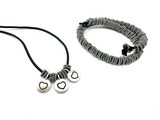Gemstone Index: Apatite
Apatite Gemstone Beads from Rings & Things: The name apatite is quite appropriate, considering this mineral makes up the teeth in all vertebrate animals (and teeth are used to satisfy one's appetite!). In fact, it comprises more than 60% of the bones and teeth in humans, fish, birds, cows, and even mammoths and dinosaurs. Apatite is a calcium phosphate that is typically green, but also can be blue, yellow, reddish-brown, violet, yellow-green ("asparagus stone"), colorless or multicolored.
Colors often form due to natural irradiation or the presence of rare earth elements. This clear to opaque stone will sometimes show a cat's-eye effect. Its name comes from the Greek word apate, meaning "to deceive," as apatite is deceivingly similar to more-valuable minerals like olivine, beryl, peridot and topaz.
Apatite is actually three different minerals, depending on the predominance of either fluorine, chlorine or the hydroxyl group. These minerals are therefore called fluorapatite, chlorapatite and hydroxylapatite. However, since it is difficult to distinguish among them, they are usually classified as a single mineral. The majority of apatite on the market is fluorapatite, the most common member.
Apatite is widely distributed in all rock types - igneous, sedimentary and metamorphic - but is usually found only as small, scattered grains or cryptocrystalline fragments. It can be cut into gems and beads, yet its softness and brittle nature have prevented it from becoming particularly popular or gaining widespread acceptance as a gemstone. Apatite is best utilized in earrings and necklaces, where it is least vulnerable to damage and will catch the light for optimum shine. Never use a steamer, hot water or ultrasonic cleaner with apatite. Mild soap, lukewarm tap water and a soft cloth are the best cleaning tools, as they won't scratch the surface or diminish its luster.
Apatite's history with humans is long, yet surprisingly vague. While the stone has been associated with appetite suppression for centuries, few other traditions are known. Its true non-gemstone uses have only been discovered in the last 100 years. For instance, since it became known as a source of phosphorus for plants, apatite has been widely used in the manufacture of fertilizers. It also is valuable in fission track dating of rocks. Archeologists especially have benefitted from the mineral - unlike shale and other rocks, apatite can uniquely preserve soft-tissue fossils. Apatite precipitates (condenses) very rapidly, forming tiny crystals that replace the muscles, blood vessels and other tissues in ancient animals. Its small crystal size means apatite can preserve delicate details of the fossilized animals' structure, providing a wealth of information for researchers. This corresponds nicely with metaphysical theory, which holds that apatite can stimulate the thoughts and ideas, and help people maintain focus, learn, concentrate effectively and think clearly. Psychics use the stone to open the third eye and bring revelations closer. Many also say it brings love, harmony and peace. Healers say it is helpful for fighting viruses and controlling weight gain. Apatite is found in Russia, Canada, Mexico, Spain, Myanmar, Brazil, Africa and the U.S.A. - its most famous crystals hail from the aptly-named Mount Apatite in Maine.
Our Bead Blog
-
Simply Springy 2-Hole Bracelet
Apr 28th 2025Designed by: Guest Designer Deb Floros Suggested Supplies 1 #61-840-50-01 Beadalon Cord, WildFire,
-
Exotic Statement Necklace
Apr 28th 2025Designed by: Guest Designer Deb Floros Suggested Supplies 1 #88-400-003-5 58x50mm Pewter Connector,
-
Rubber Tubing Necklace and Memory Wire Bracelet Set
Mar 21st 2025Designed by: Guest Designer Deb Floros Suggested Supplies 1 #61-622-02 2mm Rubber Cord, Bulk, for J



